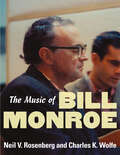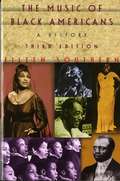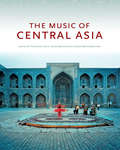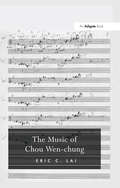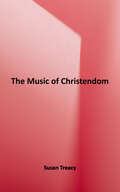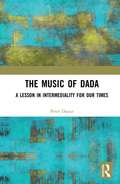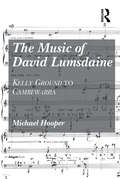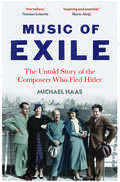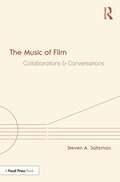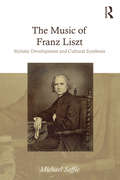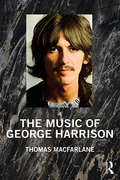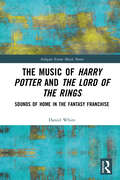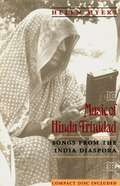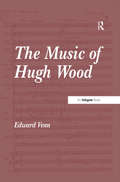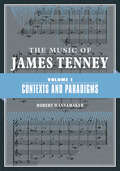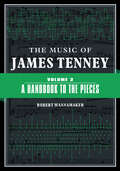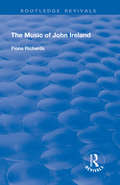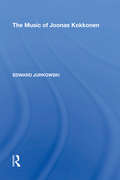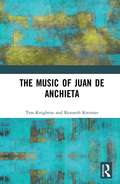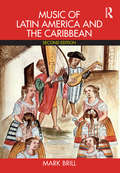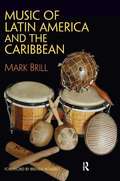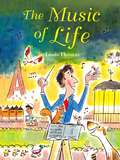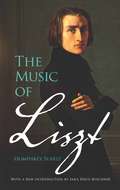- Table View
- List View
The Music of Bill Monroe (Music in American Life)
by Neil V. Rosenberg Charles K. WolfeSpanning over 1,000 separate performances, The Music of Bill Monroe presents a complete chronological list of all of Bill Monroe’s commercially released sound and visual recordings. Each chapter begins with a narrative describing Monroe’s life and career at that point, bringing in producers, sidemen, and others as they become part of the story. The narratives read like a “who’s who” of bluegrass, connecting Monroe to the music’s larger history and containing many fascinating stories. The second part of each chapter presents the discography. Information here includes the session’s place, date, time, and producer; master/matrix numbers, song/tune titles, composer credits, personnel, instruments, and vocals; and catalog/release numbers and reissue data. The only complete bio-discography of this American musical icon, The Music of Bill Monroe is the starting point for any study of Monroe’s contributions as a composer, interpreter, and performer.
The Music of Black Americans: A History (3rd Edition)
by Eileen SouthernA comprehensive history from the colonial period through the late 20th century, by a leading author in the field of African-American music
The Music of Central Asia
by Elmira Köchümkulova Saida Daukeyeva Theodore LevinThis beautiful and informative enhanced ebook—so comprehensive it had to be split into two volumes, ebook 1 and ebook 2—offers a detailed introduction to the musical heritage of Central Asia for readers and listeners worldwide. Music of Central Asia balances "insider" and "outsider" perspectives with contributions by 27 authors from 14 countries. This stunning electronic book allows readers the opportunity to deeply engage with source material through over 180 embedded audio and video, pop-up study questions, transliterations and translations of performed texts, and direct links to the companion website (www.musicofcentralasia.org). The audio and video examples include transliterations and translations of the performed texts and a follow-along feature highlights the song lyrics in the text, as the audio samples play. This generously illustrated book is supplemented with boxes and sidebars, musician profiles, and an illustrated glossary of musical instruments, making it an indispensable resource for both general readers and specialists.Ebook 1 includes part I, "Music and Culture in Central Asia," an introductory overview of the music and musical instruments of Central Asia, and part II, "The Nomadic World," which focuses on music and musical life in historically nomadic regions of Central Asia. Ebook 2 contains part III, "The World of Sedentary Dwellers," which focuses on music and musical life in historically settled regions of Central Asia, and part IV, "Central Asian Music in the Age of Globalization," which addresses "the future of the past," focusing on cultural revitalization and renewal, tradition-based popular music, and contemporary music inspired but not constrained by tradition.
The Music of Central Asia
by Theodore LevinThis beautiful and informative enhanced ebook—so comprehensive it had to be split into two volumes, ebook 1 and ebook 2—offers a detailed introduction to the musical heritage of Central Asia for readers and listeners worldwide. Music of Central Asia balances "insider" and "outsider" perspectives with contributions by 27 authors from 14 countries. This stunning electronic book allows readers the opportunity to deeply engage with source material through over 180 embedded audio and video, pop-up study questions, transliterations and translations of performed texts, and direct links to the companion website (www.musicofcentralasia.org). The audio and video examples include transliterations and translations of the performed texts and a follow-along feature highlights the song lyrics in the text, as the audio samples play. This generously illustrated book is supplemented with boxes and sidebars, musician profiles, and an illustrated glossary of musical instruments, making it an indispensable resource for both general readers and specialists.Ebook 1 includes part I, "Music and Culture in Central Asia," an introductory overview of the music and musical instruments of Central Asia, and part II, "The Nomadic World," which focuses on music and musical life in historically nomadic regions of Central Asia. Ebook 2 contains part III, "The World of Sedentary Dwellers," which focuses on music and musical life in historically settled regions of Central Asia, and part IV, "Central Asian Music in the Age of Globalization," which addresses "the future of the past," focusing on cultural revitalization and renewal, tradition-based popular music, and contemporary music inspired but not constrained by tradition.
The Music of Chou Wen-chung
by EricC. LaiChou Wen-chung is one of the most influential musical figures of our time. His rich cultural background, his studies with Edgard Var and his interest in the genuine rapport between Eastern and Western musical traditions have been the major influences on his career. Although he is active in various artistic and cultural circles that include scholarship, education and cultural preservation, his major calling has always been composition. As a composer, Chou has created a group of works whose stylistic innovation and technical profundity are distinctive among composers of his generation. His music, which has received critical acclaim around the globe, documents his creative journey, especially in the realization of re-merger - the fusion of Eastern and Western music that has become a new mainstream in art music. Through extensive focus on sketch study, Eric Lai examines Chou's music to contribute to an understanding of his aesthetic orientation, his compositional technique, his role in the development of new music, and his influence upon the younger generation of composers.
The Music of Christendom: A History
by Susan TreacyMusic plays such an important part in everyone's life but how much do we know about the history of music? How did music shape our civilization and how was music itself shaped by the Catholic Church? Susan Treacy, an experienced professor of music, is an excellent guide to the history of music. Every Catholic should own at least one book on music. This is it.
The Music of Dada: A lesson in intermediality for our times
by Peter Dayan100 years after the Dada soirées rocked the art world, the author investigates the role that music played in the movement. Dada is generally thought of as noisy and unmusical, but The Music of Dada shows that music was at the core of Dada theory and practice. Music (by Schoenberg, Satie and many others) performed on the piano played a central role in the soirées, from the beginnings in Zurich, in 1916, to the end in Paris and Holland, seven years later. The Music of Dada provides a historical analysis of music at Dada events, and asks why accounts of Dada have so consistently ignored music’s vital presence. The answer to that question turns out to explain how music has related to the other arts ever since the days of Dada. The music of Dada is the key to understanding intermediality in our time.
The Music of David Lumsdaine: Kelly Ground to Cambewarra
by Michael HooperAustralian by birth but a longtime resident of Great Britain, David Lumsdaine (b.1931) is central to both Australian and British modernism. During the early 1970s Australian musical modernism was at its height. Lumsdaine and his Australian contemporaries were engaged with practices from multiple places, producing music that displays the attributes of their disparate influences; in so doing they formed a new conception of what it meant to be an Australian composer. The period is similarly important in Britain, for it saw the rise to prominence of composers such as Birtwistle, Davies, Goehr, Gilbert, Wood, Cardew and many others who were Lumsdaine's contemporaries, colleagues and friends. Hooper presents here a series of analyses of Lumsdaine's compositions, focusing on works written between 1966 and 1980. At the early end of this period is Kelly Ground, for solo piano. One of Lumsdaine's first acknowledged works, Kelly Ground connects explicitly with the music of high modernism, employing ideas about temporality as espoused by Ligeti, Stockhausen and Boulez, to form a new ritual for the (now mythical) Australian outlaw Ned Kelly. Hooper places Lumsdaine's music in the context of Australian and British avant-gardes, and reveals its elegance, lyricism and technical virtuosity.
Music of Exile: The Untold Story of the Composers who Fled Hitler
by Michael HaasWhat happens to a composer when persecution and exile means their true music no longer has an audience? In the 1930s, composers and musicians began to flee Hitler&’s Germany to make new lives across the globe. The process of exile was complex: although some of their works were celebrated, these composers had lost their familiar cultures and were forced to navigate xenophobia as well as entirely different creative terrain. Others, far less fortunate, were in a kind of internal exile—composing under a ruthless dictatorship or in concentration camps and ghettos. Michael Haas sensitively records the experiences of this musical diaspora. Torn between cultures and traditions, these composers produced music that synthesized old and new worlds, some becoming core portions of today&’s repertoire, some relegated to the desk drawer. Encompassing the musicians interned as enemy aliens in the United Kingdom, the brilliant Hollywood compositions of Erich Wolfgang Korngold, and the Brecht-inspired theater music of Kurt Weill, Haas shows how these musicians shaped the twentieth-century soundscape—and offers a moving record of the incalculable effects of war on culture.
The Music of Film: Collaborations and Conversations
by Steven A. SaltzmanThe Music of Film opens up the world of film music from the inside. Through a series of interviews and conversations with professional composers, music supervisors, music editors, and picture editors, this book shows how music for film and television works according to insiders in the industry. Here we find a comprehensive collection of techniques and personal insights and get a unique perspective on how these key players in postproduction interact, collaborate, and successfully build their careers. The Music of Film is essential reading for composers, editors, directors, and producers—aspiring and established alike—or anyone interested in learning how to start or manage a profession working with music in feature films, television, and other media.
The Music of Franz Liszt: Stylistic Development and Cultural Synthesis
by Michael SaffleMuch of Franz Liszt's musical legacy has often been dismissed as 'trivial’ or 'merely showy,' more or less peripheral contributions to nineteenth-century European culture. But Liszt was a mainstream composer in ways most of his critics have failed to acknowledge; he was also an incessant and often extremely successful innovator. Liszt's mastery of fantasy and sonata traditions, his painstaking settings of texts ranging from erotic verse to portions of the Catholic liturgy, and the remarkable self-awareness he demonstrated even in many of his most 'entertaining' pieces: all these things stamp him not only as a master of Romanticism and an early Impressionist, but as a precursor of Postmodern 'pop.' Liszt's Music places Liszt in historical and cultural focus. At the same time, it examines his principal contributions to musical literature -- from his earliest operatic paraphrases to his final explorations of harmonic and formal possibilities. Liszt's compositional methods, including his penchant for revision, problems associated with early editions of some of his works, and certain aspects of class and gender issues are also discussed. The first book-length assessment of Liszt as composer since Humphrey Searle’s 1956 volume, Liszt's Music is illustrated with well over 100 musical examples.
The Music of George Harrison
by Thomas MacFarlaneGeorge Harrison was one of the most prolific popular music composers of the late 20th century. During his tenure with the Beatles, he caught the wave of 1960s pop culture and began channeling its pervasive influence through his music. Often described as "The Invisible Singer," his solo recordings reveal him to be an elusive, yet essential, element in the Beatles’ sound. The discussion of George Harrison’s Beatle tracks featured in the text employs a Songscape approach that blends accessible music analysis with an exploration of the virtual space created on the sound recording. This approach is then used to explore Harrison’s extensive catalog of solo works, which, due to their varied cultural sources, seem increasingly like early examples of Global Pop. In that sense, the music of George Harrison may ultimately be viewed as an important locus for pan-cultural influence in the 20th century, making this book essential reading for those interested in the history of songwriting and recording as well as the cultural study of popular music.
The Music of Harry Potter and The Lord of the Rings: Sounds of Home in the Fantasy Franchise (Ashgate Screen Music Series)
by Daniel WhiteThe Music of Harry Potter and The Lord of the Rings provides an in-depth study of the music of two of the biggest fantasy franchises, focussing on music’s worldbuilding roles within the film-watching experience and elsewhere in videogames, trailers, plays, theme parks and other attractions, and the world of fandom.Daniel White takes a range of approaches and techniques of motivic and thematic musical analysis, and pairs this with transformational harmonic analysis to theorise music’s worldbuilding roles in film. Chapters focus in turn on the opening sequences of the case study franchise films, their closing sequences, and on their depiction of houses, homes and homelands. Extra-filmic areas of these fantasy worlds are also explored, including theme parks and other tourist attractions of the Harry Potter franchise, videogames and the immersive power of their music, and the world of fandom with a focus on soundtrack consumption and other musical fan practices. Through this multifaceted approach, readers gain a deeper understanding not only of the music of these franchises, but also of music’s power in the multimedia franchise both within and without film to build a home that attracts inhabitants. This book will be valuable for academics and students as well as fans of fantasy franchises.
Music of Hindu Trinidad: Songs from the India Diaspora (Chicago Studies in Ethnomusicology)
by Helen MyersMusic of Hindu Trinidad is a fascinating account of the history and cultural significance of Hindu music that explores its symbolic, aesthetic, and psychological aspects while asking the larger question of how this music has contributed to the formation of identity in the midst of their great diaspora.
The Music of Hugh Wood
by Edward VennThe Music of Hugh Wood provides the first ever in-depth study of this well-known, yet only briefly documented composer. Over the years, Wood (b. 1932) has produced a sizeable oeuvre that explores the established genres of symphony, concerto, and quartet on the one hand, and songs and choruses on the other. Underpinned by an awareness of recent philosophical, theoretical and analytical concepts, Dr Edward Venn highlights both the technical basis of Wood's music and the expressive force of his work. In doing so, a picture emerges of Wood as an artist of considerable merit and power. The eclectic blend of national and international influences in the music of Hugh Wood combine to create an individual and distinctive musical language all his own. The book provides an overview of Wood's style, focussing on his engagement with modernism and the melodic, rhythmic, harmonic and formal characteristics of his musical language. From here a more detailed consideration of Wood's development as a composer is advanced, in which his technical development is illustrated alongside an exploration of various aspects of musical meaning embodied in his works. In the process, numerous analytical strategies ranging from formalist to narrative structures are utilized, demonstrating the fecundity and expressivity of Wood's music.
The Music of James Tenney: Volume 1: Contexts and Paradigms
by Robert WannamakerParsing the works of the experimental music pioneer Robert Wannamaker's monumental two-volume study explores the influential music and ideas of American composer, theorist, writer, performer, and educator James Tenney. Delving into the whole of Tenney's far-ranging oeuvre, Wannamaker provides in-depth, aurally grounded analyses of works linked to the artist's revolutionary theories of musical form, timbre, and harmonic perception. Volume 1, Contexts and Paradigms, chronologically surveys Tenney's creative development and output. Wannamaker begins each section with biographical, aesthetic, and technical context that illuminates a distinct period in Tenney's career. From there, he analyzes a small number of pieces that illuminate the concerns, characteristics, and techniques that emerged in Tenney's music during that time. Wannamaker supplements the text with musical examples, graphs, and diagrams while also drawing on unpublished material and newly available primary sources to flesh out each work and the ideas that shaped it. A landmark in experimental music scholarship, The Music of James Tenney is a first-of-its-kind consideration of the experimental music titan and his work.
The Music of James Tenney: Volume 2: A Handbook to the Pieces
by Robert WannamakerA work-by-work guide to the composer's groundbreaking music Robert Wannamaker's monumental two-volume study explores the influential music and ideas of American composer, theorist, writer, performer, and educator James Tenney. Delving into the whole of Tenney's far-ranging oeuvre, Wannamaker offers close, aurally grounded analyses of works linked to the artist's revolutionary theories of musical form, timbre, and harmonic perception. Written as a reference work, Volume 2, A Handbook to the Pieces, presents detailed entries on Tenney's significant post-1959 experimental works (excepting pieces covered in volume 1). Wannamaker includes technical information, an analysis of intentions and goals, graphs and musical examples, historical and biographical context, and thoughts from Tenney and others on specific works. Throughout, he discusses the striking compositional ideas found in Tenney's music and, where appropriate, traces an idea's appearance from one piece to the next to reveal the evolution of the composer's art and thought. A landmark in experimental music scholarship, The Music of James Tenney is a first-of-its-kind consideration of the experimental music titan and his work.
The Music of John Ireland
by Fiona RichardsThis title was first published in 2000. John Ireland (1879-1962) was as elusive as the music that he composed. His music resists easy categorization, in part because it is linked so closely to specific events, places and people in Ireland's personal life. The Music of John Ireland explores the expressive and extramusical qualities of Ireland's compositions and their complex system of personal musical symbols, images and ideas. Fiona Richards interweaves biography and musical analysis in a series of chapters which take their themes from the significant influences in Ireland's life: Anglo-Catholicism, paganism, the countryside, the city, love and war. Ireland emerges as highly individual, struggling with his religious beliefs, his sexuality, and an uncertainty as to his success. His music, often an expression of a state of mind, is given, for the first time, the close investigation that it merits. Ireland preferred to compose on a small scale, showing a masterful command of form and a gift for melody. Richards reveals how the essence of the man shines through in the miniatures that he wrote.
The Music of Joonas Kokkonen
by Edward JurkowskiJoonas Kokkonen (1921-1996) has been one of the most performed Finnish composers during the past 25 years both within Finland and abroad.The author's study of Joonas Kokkonen is the first full-scale account in English. Starting with a brief survey of Finnish music during the 20th century, the book then devotes a separate chapter to each of the major genres in which Kokkonen composed: symphonic, orchestral, vocal, chamber and keyboard. Illustrated with over a hundred music examples, The Music of Joonas Kokkonen seeks to overturn his reputation in some quarters as a conservative, even old fashioned, composer, and argues that Kokkonen created an interesting and refreshing approach to dodecaphonic composition and pitch organization. With a full chronological listing of works and bibliography, this book is the most important reference source to date on Kokkonen and his music." "Book Description: One of the most performed Finnish composers during the last 25 years, Joonas Kokkonen (1921-1996) was also instrumental in the development of the nation's system of music education. In this study,the author (music, U. of Lethbridge, Canada) examines Kokkonen's compositions in each of five major genres: symphonic, orchestral, vocal, chamber, and key
The Music of Juan de Anchieta
by Tess Knighton Kenneth KreitnerThis book explores Juan de Anchieta’s life and his music and, for the first time, presents a critical study of the life and works of a major Spanish composer from the time of Ferdinand and Isabel. A key figure in musical developments in Spain in the decades around 1500, Anchieta served in the Castilian royal chapel for over thirty years, from his appointment in 1489 as a singer in the household of Queen Isabel, and he continued to receive a pension from her grandson, the Emperor Charles V, until his death in 1523. He traveled to Flanders in the service of the Catholic Monarchs’ daughter Juana, and was briefly music master to Charles himself. Anchieta, along with Francisco de Peñalosa, his contemporary in the Aragonese chapel, and a few others, was a key figure in the rise of elaborate written polyphony in the Spain of Josquin’s time. The book brings together two of the leading specialists in Spanish music of the era in order to review and revise the rich biographical material relating to Anchieta’s life, and the historiographical traditions which have dominated its telling. After a biographical overview, the chapters focus on specific genres of his music, sacred and secular, with suggestions as to a possible chronology of his work based on its codicology and style, and consideration of the contexts in which it was conceived and performed. A final chapter summarizes his achievement and his influence in his own time and after his death. As the first comprehensive study of Anchieta’s life and works, The Music of Juan de Anchieta is an essential addition to the history of Spanish music.
Music of Latin America and the Caribbean
by Mark BrillMusic of Latin America and the Caribbean, Second Edition is a comprehensive textbook for undergraduate students, which covers all major facets of Latin American music, finding a balance between important themes and illustrative examples. This book is about enjoying the music itself and provides a lively, challenging discussion complemented by stimulating musical examples couched in an appropriate cultural and historical context—the music is a specific response to the era from which it emerges, evolving from common roots to a wide variety of musical traditions. Music of Latin America and the Caribbean aims to develop an understanding of Latin American civilization and its relation to other cultures. NEW to this edition A new chapter overviewing all seven Central American countries An expansion of the chapter on the English- and French-speaking Caribbean An added chapter on transnational genres An end-of-book glossary featuring bolded terms within the text A companion website with over 50 streamed or linked audio tracks keyed to Listening Examples found in the text, in addition to other student and instructors’ resources Bibliographic suggestions at the end of each chapter, highlighting resources for further reading, listening, and viewing Organized along thematic, historical, and geographical lines, Music of Latin America and the Caribbean implores students to appreciate the unique and varied contributions of other cultures while realizing the ways non-Western cultures have influenced Western musical heritage. With focused discussions on genres and styles, musical instruments, important rituals, and the composers and performers responsible for its evolution, the author employs a broad view of Latin American music: every country in Latin America and the Caribbean shares a common history, and thus, a similar musical tradition.
Music of Latin America and the Caribbean
by Mark BrillThe Music of Latin America and the Caribbean is the first text written on the rich musical heritage of this region specifically for the non-music major. The text is arranged by region, focusing on the major countries/regions (Mexico, Brazil, Peru, etc. in Latin America and Jamaica, the Virgin Islands, Haiti, etc. in the Caribbean). In each chapter, the author gives a complete history of the region's music, ranging from classical and classical-influenced styles to folk and traditional music to today's popular music.
The Music of Life
by Louis ThomasFull of joy and discovery, Louis Thomas' The Music of Life is a simple, melodious picture book about finding big inspiration and beauty in the smallest of details.At night when everyone else is asleep, one artist sits awake--pencil in hand, stuck. Lenny is a composer, but this evening, no music floats from his head. Then as night breaks into dawn, Lenny's cat, Pipo, begins lapping milk. Lick lick lick. Birds yawn awake, singing in the trees. Tweet tweet! A bike bell tings on the street below. Suddenly, Lenny notices a rhythm to the world around him. He pulls on his coat and walks through the city to write down every sound he can find. Lenny listens to a gardener, a jogger, a dogwalker, and more neighborhood characters. Finally, the morning's sounds culminate in a sun-dappled symphony that Lenny conducts in the center of the park.
The Music of Liszt
by Humphrey SearleThis is the most authoritative study of Liszt's music, being a survey of his 700 compositions and a review of his place in the history of music.
The Music of Liszt
by Humphrey Searle Sara Davis BuechnerVirtuoso pianist Franz Liszt was a key figure in the evolution of modern music. Most of his 700 compositions, which range from romantic impressionism to daring experimental pieces, were written for the piano. This survey by a well-known British composer and musicologist constitutes the most authoritative English-language study of Liszt's works. "Mr. Searle is himself a composer of progressive outlook and he thus speaks with authority. His book was needed and he has made it a good one," observed the Times (London) Literary Supplement. This classic study surveys the compositions in chronological order and the medium for which they were written. The author examines in detail the most important pieces and fully reviews Liszt's place in history. Subjects include romantic pieces, symphonic poems, songs, symphonies, and other works. A biographical summary illustrates the relationship between significant works and events in the composer's life. Acclaimed by Library Journal as "a balanced, long-overdue treatment," this study is essential for every true Lisztian student.
